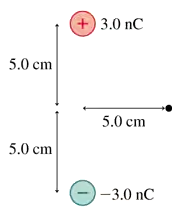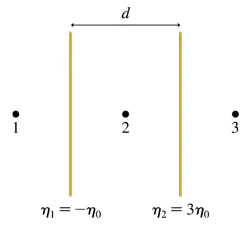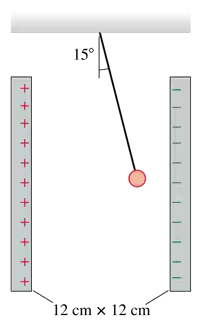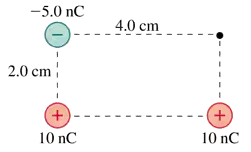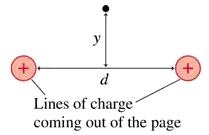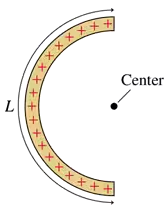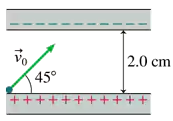 Back
BackProblem 3
What are the strength and direction of the electric field at the position indicated by the dot in FIGURE EX23.3? Specify the direction as an angle cw from horizontal.
Problem 5a
The electric field strength 1.5 cm from an electric dipole, on the axis of the dipole, is 1.5×105 N/C. What is the dipole moment in nC mm?
Problem 5c
The electric field strength 1.5 cm from an electric dipole, on the axis of the dipole, is 1.5×105 N/C. If the dipole is replaced by a single charge, what magnitude charge in nC will give the same field strength 1.5 cm away?
Problem 6a
An electric dipole is formed from two charges, ±q, spaced 1.0 cm apart. The dipole is at the origin, oriented along the y-axis. The electric field strength at the point (x, y)=(0 cm, 10 cm) is 360 N/C. What is the charge q? Give your answer in nC.
Problem 7
An electret is similar to a magnet, but rather than being permanently magnetized, it has a permanent electric dipole moment. Suppose a small electret with electric dipole moment 1.0×10−7 C m is 25 cm from a small ball charged to +25 nC, with the ball on the axis of the electric dipole. What is the magnitude of the electric force on the ball?
Problem 8
A 10-cm-long thin glass rod uniformly charged to +10 nC and a 10-cm-long thin plastic rod uniformly charged to −10 nC are placed side by side, 4.0 cm apart. What are the electric field strengths E1 to E3 at distances 1.0 cm, 2.0 cm, and 3.0 cm from the glass rod along the line connecting the midpoints of the two rods?
Problem 10
A small glass bead charged to +6.0 nC is in the plane that bisects a thin, uniformly charged, 10-cm-long glass rod and is 4.0 cm from the rod's center. The bead is repelled from the rod with a force of 840 μN. What is the total charge on the rod?
Problem 11
Two 10-cm-long thin glass rods uniformly charged to +10 nC are placed side by side, 4.0 cm apart. What are the electric field strengths E1 to E3 at distances 1.0 cm, 2.0 cm, and 3.0 cm to the right of the rod on the left along the line connecting the midpoints of the two rods?
Problem 13
CALC A 12-cm-long thin rod has the nonuniform charge density , where x is measured from the center of the rod. What is the total charge on the rod? Hint: This exercise requires an integration. Think about how to handle the absolute value sign.
Problem 15a
Two 10-cm-diameter charged rings face each other, 20 cm apart. The left ring is charged to −20 nC and the right ring is charged to +20 nC. What is the electric field Ē, both magnitude and direction, at the midpoint between the two rings?
Problem 15b
Two 10-cm-diameter charged rings face each other, 20 cm apart. The left ring is charged to −20 nC and the right ring is charged to +20 nC. What is the force on a proton at the midpoint?
Problem 16a
Two 10-cm-diameter charged disks face each other, 20 cm apart. The left disk is charged to −50 nC and the right disk is charged to +50 nC. a. What is the electric field Ē, both magnitude and direction, at the midpoint between the two disks?
Problem 19
You’ve hung two very large sheets of plastic facing each other with distance d between them, as shown in FIGURE EX23.19. By rubbing them with wool and silk, you’ve managed to give one sheet a uniform surface charge density and the other a uniform surface charge density . What are the electric field vectors at points 1, 2, and 3?
Problem 24
Air 'breaks down' when the electric field strength reaches 3.0×106 N/C, causing a spark. A parallel-plate capacitor is made from two 4.0 cm×4.0 cm electrodes. How many electrons must be transferred from one electrode to the other to create a spark between the electrodes?
Problem 25
FIGURE EX23.25 shows a g ball hanging from a string inside a parallel-plate capacitor made with 12 cm × 12 cm electrodes. The electrodes are charged to ±75 nC. What is the charge on the ball in nC?
Problem 27b
Two 2.0-cm-diameter disks face each other, 1.0 mm apart. They are charged to ±10 nC. A proton is shot from the negative disk toward the positive disk. What launch speed must the proton have to just barely reach the positive disk?
Problem 29
INT The surface charge density on an infinite charged plane is −2.0×10−6 C/m2. A proton is shot straight away from the plane at 2.0×106 m/s. How far does the proton travel before reaching its turning point?
Problem 30
A proton is fired horizontally into a 1.0×105 N/C vertical electric field. It rises 1.0 cm vertically after having traveled 5.0 cm horizontally. What was the proton's initial speed?
Problem 31b
Electrostatic cleaners remove small dust particles and pollen grains from air by first ionizing them, then flowing the air between the plates of a parallel-plate capacitor, parallel to the plates, where electric forces deposit charged particles on one of the electrodes. A typical pollen grain has a mass of g, the ionizer charges it with extra electrons, and a fan moves the air at m/s. Ignore air resistance and gravity. What minimum electric field strength is needed to deflect the grain by mm before it leaves the electrodes?
Problem 34
The permanent electric dipole moment of the water molecule (H2O) is Cm. What is the maximum possible torque on a water molecule in a N/C electric field?
Problem 37
What are the strength and direction of the electric field at the position indicated by the dot in FIGURE P23.37? Give your answer (a) in component form and (b) as a magnitude and angle measured cw or ccw (specify which) from the positive x-axis.
Problem 40
A −15 nC charge is at x=+2.0 cm on the x-axis. A second charge q is located somewhere on the x-axis to the left of the origin. The electric field at y=2.0 cm on the y-axis is N/C . What are (a) the charge q in nC and (b) its distance from the origin?
Problem 41
FIGURE P23.41 is a cross section of two infinite lines of charge that extend out of the page. Both have linear charge density λ. Find an expression for the electric field strength E at height y above the midpoint between the lines.
Problem 43
Derive Equation 23.11 for the field Ē dipole in the plane that bisects an electric dipole.
Problem 44c
FIGURE P23.44 shows a thin rod of length L with total charge Q. Evaluate E at r=3.0 cm if L=5.0 cm and Q=3.0 nC.
Problem 47
A ring of radius R has total charge Q. At what distance along the z-axis is the electric field strength a maximum?
Problem 48a
Charge Q is uniformly distributed along a thin, flexible rod of length L. The rod is then bent into the semicircle shown in FIGURE P23.48. Find an expression for the electric field Ē at the center of the semicircle. Hint: A small piece of arc length Δs spans a small angle Δθ=Δs/R , where R is the radius.
Problem 50
An infinite plane of charge with surface charge density 3.2 μC/m2 has a 20-cm-diameter circular hole cut out of it. What is the electric field strength directly over the center of the hole at a distance of 12 cm? Hint: Can you create this charge distribution as a superposition of charge distributions for which you know the electric field?
Problem 51
CALC A uniform electric field’s strength is increasing with time as . A proton is released in the field from rest at t = 0. What is the proton’s speed 1.0 μs later?
Problem 53
The two parallel plates in FIGURE P23.53 are 2.0 cm apart and the electric field strength between them is 1.0×104 N/C. An electron is launched at a 45° angle from the positive plate. What is the maximum initial speed v0 the electron can have without hitting the negative plate?

